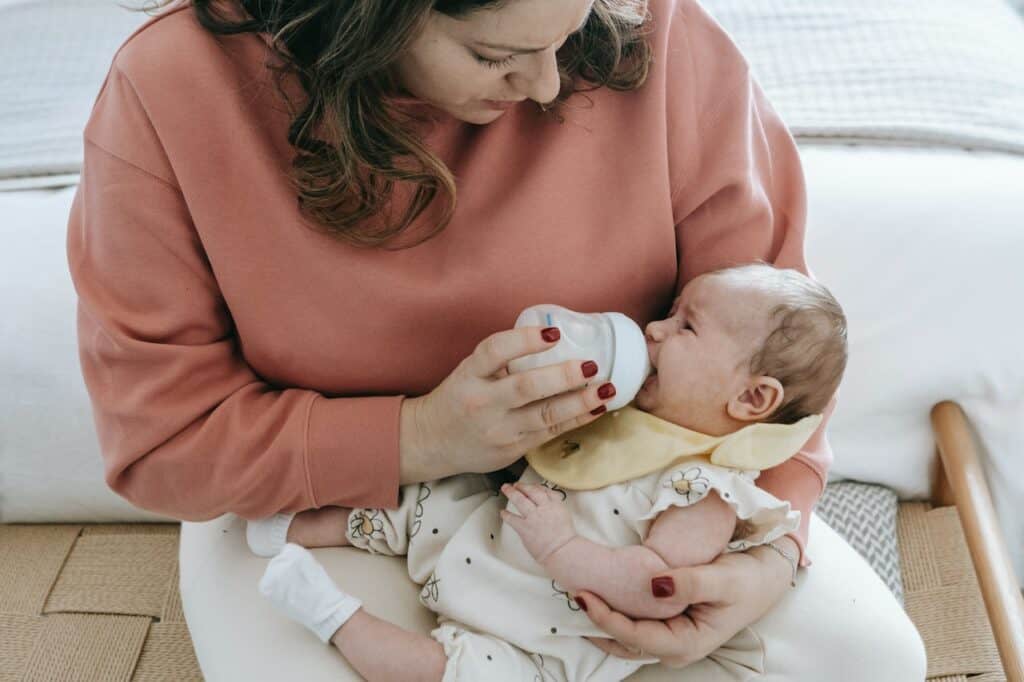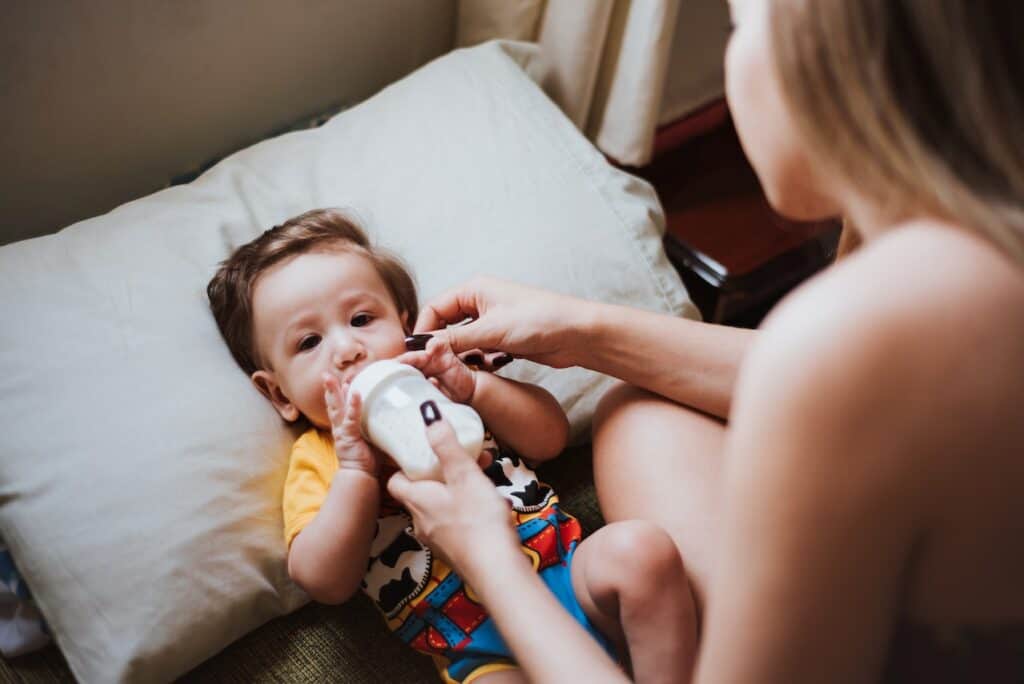Many parents find themselves struggling when their baby refuses to take a bottle at daycare. This can be a frustrating and stressful experience for both the parent and the caregiver. Understanding the issue, possible reasons for refusal, and the role of caregivers in bottle feeding can help parents create a feeding plan that works for their baby.
Babies may refuse a bottle at daycare for various reasons, including a transition from breastfeeding to bottle, a preference for a certain type of bottle or nipple, a change in routine, or separation anxiety. It is essential for parents to work closely with their caregivers to identify the underlying cause of refusal and develop a plan to address it. This may involve experimenting with different bottles or nipples, adjusting the feeding schedule, or finding alternative ways to provide nutrition.
Key Takeaways
- Babies may refuse a bottle at daycare for various reasons, including a transition from breastfeeding to bottle, a preference for a certain type of bottle or nipple, a change in routine, or separation anxiety.
- Caregivers play a vital role in bottle feeding and can help parents identify the underlying cause of refusal and develop a plan to address it.
- Consulting with a pediatrician and creating a feeding plan that works for both the baby and caregiver can help alleviate the stress and frustration of bottle refusal at daycare.
Understanding the Issue: Baby Refusing Bottle at Daycare
When a baby refuses a bottle at daycare, it can be a frustrating and concerning experience for both the caregiver and the parent. There are several reasons why a baby may refuse a bottle, and it is important to understand the issue in order to find a solution.
One common reason why a baby may refuse a bottle at daycare is due to separation anxiety. Babies may feel stressed and anxious when away from their parents, which can cause them to reject their bottle. This can be especially true for younger babies who are still adjusting to being away from their primary caregiver.
Another reason why a baby may refuse a bottle is due to a change in routine. Babies thrive on routine, and any changes to their schedule can be upsetting. If a baby is used to being fed at a certain time or in a certain way, a change in routine can cause them to refuse their bottle.
It is also possible that a baby may refuse a bottle due to teething or illness. When a baby is teething, they may experience discomfort in their mouth, making it difficult for them to suck on a bottle. Similarly, if a baby is sick, they may not have the appetite or energy to take a bottle.
In some cases, a baby may simply prefer breastfeeding over bottle-feeding. Breastfeeding provides a unique bonding experience between mother and baby, and some babies may have a strong preference for it. In this case, it may be helpful to try different types of bottles or nipples to find one that the baby is more comfortable with.
Overall, when a baby refuses a bottle at daycare, it is important to approach the situation with patience and understanding. By identifying the underlying cause of the issue, caregivers and parents can work together to find a solution that works for everyone involved.
Possible Reasons for Refusal
When a baby refuses to take a bottle at daycare, it can be concerning for parents and caregivers alike. There are several possible reasons why a baby may refuse a bottle, and understanding these reasons can help parents and caregivers find solutions to the problem.

Comfort and Familiarity
One possible reason why a baby may refuse a bottle at daycare is that they are not comfortable with the new environment. Babies thrive on routine and familiarity, and being in a new environment can be overwhelming for them. In such cases, it is important to ensure that the baby feels comfortable and secure in their surroundings. Parents can try sending a familiar object, such as a blanket or toy, with the baby to provide a sense of security.
Teething and Discomfort
Teething can be a painful and uncomfortable process for babies, and it can affect their appetite. If a baby is teething, they may refuse to take a bottle due to the discomfort. In such cases, parents can try offering a cold teething toy or a chilled teething ring to soothe the baby’s gums before feeding.
Feeding Position and Bottle Issues
The position in which a baby is fed can also affect their willingness to take a bottle. If a baby is uncomfortable or in an awkward position, they may refuse the bottle. Additionally, issues with the bottle or nipple, such as a slow flow or a damaged nipple, can also cause a baby to refuse the bottle. In such cases, parents should try adjusting the feeding position or trying a different bottle or nipple.
Hunger and Feeding Schedule
If a baby is hungry or not on their regular feeding schedule, they may refuse a bottle. It is important to ensure that the baby is fed on a regular schedule and that they are not hungry before attempting to feed them. Additionally, parents can try offering smaller, more frequent feedings to help the baby adjust to the new environment.
Illness and Infection
Finally, if a baby is sick or has an infection, they may refuse a bottle due to the discomfort or pain. In such cases, it is important to seek medical attention and follow the doctor’s recommendations for feeding the baby.
Overall, there are several possible reasons why a baby may refuse a bottle at daycare. By understanding these reasons and addressing them appropriately, parents and caregivers can help ensure that the baby is getting the nutrition they need.
Transition from Breastfeeding to Bottle
Transitioning a breastfed baby to a bottle can be a challenging experience for both the baby and the caregiver. It is important to approach this transition with patience and understanding, as it may take several attempts before the baby accepts the bottle.
One of the first steps in transitioning a breastfed baby to a bottle is to introduce the baby to the bottle nipple. It is recommended to choose a nipple that closely resembles the shape and feel of the mother’s nipple, as this can make the transition smoother. Caregivers may need to experiment with different types of nipples to find the one that the baby prefers.
When introducing the bottle, it is important to offer it to the baby when they are not overly hungry or fussy. This can help the baby to be more receptive to the bottle. Caregivers may also want to try different positions for feeding, as some babies may prefer to be held differently when taking a bottle.
It is important to note that some babies may initially refuse the bottle, and this is normal. Caregivers should not force the baby to take the bottle, as this can create a negative association with feeding. Instead, caregivers can try offering the bottle at different times throughout the day, and gradually increase the amount of bottle feedings over time.
Overall, transitioning a breastfed baby to a bottle can be a gradual process that requires patience and persistence. With the right approach and a bit of experimentation, caregivers can help their baby to successfully make the transition to bottle feeding.
Role of Caregivers in Bottle Feeding
Caregivers play a crucial role in ensuring that a baby receives adequate nutrition through bottle feeding while at daycare. Here are some factors that caregivers should consider:

Feeding Position
Caregivers should ensure that the baby is in a comfortable and safe position during feeding. The baby should be held close to the caregiver’s body, with the head slightly elevated. This helps prevent choking and makes it easier for the baby to swallow.
Routine
Establishing a consistent feeding routine can help the baby feel more secure and comfortable. Caregivers should work with parents to understand the baby’s feeding schedule and preferences. They should also communicate any changes in the baby’s feeding routine to parents.
Play
Caregivers should encourage the baby to play and engage in age-appropriate activities. This can help distract the baby during feeding and make the experience more enjoyable. Caregivers should also avoid feeding the baby while they are upset or crying, as this can make it more difficult for them to eat.
Daycare
Caregivers should ensure that the daycare environment is conducive to feeding. This includes providing a quiet and comfortable space for feeding, as well as ensuring that bottles and other feeding equipment are clean and readily available.
Overall, caregivers play a critical role in ensuring that babies receive adequate nutrition through bottle feeding while at daycare. By considering factors such as feeding position, routine, play, and the daycare environment, caregivers can help make feeding a positive and enjoyable experience for both the baby and parents.
Alternatives to Bottle Feeding
Parents may face challenges when their baby refuses to take a bottle at daycare. However, there are alternatives to bottle feeding that can help ensure the baby is getting the nutrition they need. Here are some options to consider:
Sippy Cups and Open Cups
Sippy cups and open cups are great alternatives to bottles, especially for older babies who are transitioning to solid foods. Sippy cups have a spout that allows the baby to drink without spilling, while open cups require the baby to use their mouth and tongue to drink.
When choosing a sippy cup or open cup, it’s important to consider the material. Some cups are made of plastic, while others are made of stainless steel or glass. Parents should also look for cups that are easy to clean and assemble.
Spoon Feeding
Spoon feeding is another option for babies who refuse to take a bottle. This method involves feeding the baby pureed or mashed food with a spoon. It’s important to introduce spoon feeding gradually and to choose foods that are appropriate for the baby’s age and development.
Parents should also be aware of the baby’s cues and avoid overfeeding. Spoon feeding can be messy, so it’s a good idea to use a bib and a high chair with a tray.
Supplement Feeding
Supplement feeding involves giving the baby formula or breast milk through a different method, such as a syringe or a dropper. This method can be helpful for babies who have difficulty latching or swallowing.
Parents should work with their healthcare provider to determine the appropriate amount of formula or breast milk to give the baby. It’s also important to sterilize all equipment used for supplement feeding to prevent the spread of germs.
In conclusion, there are several alternatives to bottle feeding that can help ensure the baby is getting the nutrition they need. Parents should consider their baby’s age and development when choosing an alternative method and should always consult with their healthcare provider if they have any concerns.
Consulting with Pediatrician
If a baby is consistently refusing a bottle at daycare, it may be time to consult with a pediatrician. The pediatrician can provide valuable advice and guidance on how to address the issue.
During the consultation, the pediatrician may ask questions about the baby’s feeding habits, sleeping patterns, and overall health. They may also conduct a physical exam to rule out any underlying medical conditions that could be causing the baby to refuse the bottle.
Based on the information gathered, the pediatrician may recommend different strategies to encourage the baby to take the bottle. This could include adjusting the feeding schedule, changing the type of bottle or nipple, or trying different feeding positions.
It is important to follow the pediatrician’s advice closely and to communicate any changes or improvements in the baby’s feeding habits. The pediatrician may also recommend follow-up appointments to monitor the baby’s progress and make any necessary adjustments to the feeding plan.
Overall, consulting with a pediatrician can be a helpful step in addressing a baby’s refusal to take a bottle at daycare. With the right guidance and support, most babies can be encouraged to take a bottle and maintain proper nutrition.
Creating a Feeding Plan
When a baby refuses to take a bottle at daycare, it can be a stressful situation for both the parents and the caregivers. Creating a feeding plan can help ensure that the baby receives the necessary nutrition while at daycare and ease the transition for the working parent.

A feeding plan should include the baby’s feeding routine and preferences. This can be determined by speaking with the parents and observing the baby’s feeding habits. For example, if the baby prefers a certain type of bottle or nipple, this should be noted in the feeding plan.
The feeding plan should also take into account the age of the baby. For a 6-month-old, the plan may include introducing solid foods and adjusting the feeding schedule accordingly.
Communication between the parents and the daycare provider is crucial in creating a successful feeding plan. The plan should be discussed and agreed upon by both parties to ensure that everyone is on the same page.
In some cases, it may be necessary to try different feeding methods or bottles to find what works best for the baby. The feeding plan should be flexible and allow for adjustments as needed.
Overall, creating a feeding plan can help ensure that the baby is receiving the necessary nutrition while at daycare and ease the transition for the working parent.
Addressing Potential Complications
When a baby refuses to take a bottle at daycare, there can be several potential complications that arise. It is important to address these issues to ensure the baby’s health and well-being.

Colic
Colic is a common condition in newborns that can cause excessive crying and discomfort. If a baby is experiencing colic, it may be difficult for them to take a bottle. Caregivers should be aware of the signs of colic and work with the baby’s parents to determine the best course of action.
Choking and Vomiting
Babies who are fussy or distracted may be more prone to choking or vomiting while feeding. Caregivers should be trained in proper feeding techniques to prevent these complications. If a baby does choke or vomit while feeding, they should be monitored closely for any signs of distress.
Diarrhea and Fever
If a baby is refusing to take a bottle and is experiencing diarrhea or fever, it may be a sign of an underlying illness. Caregivers should be aware of these symptoms and take appropriate measures to ensure the baby’s health and safety.
Trauma
In some cases, a baby may refuse a bottle due to trauma or injury. Caregivers should be aware of any signs of trauma or injury and take appropriate action to ensure the baby’s well-being.
Fussy or Distracted
Babies who are fussy or distracted may have difficulty taking a bottle. Caregivers should work with the baby’s parents to determine the best course of action to ensure the baby’s feeding needs are met.
Uncomfortable
If a baby is uncomfortable, they may refuse to take a bottle. Caregivers should be aware of any signs of discomfort and take appropriate measures to ensure the baby’s comfort.
Baby Refuses to Eat
If a baby refuses to eat, it may be a sign of an underlying issue. Caregivers should work with the baby’s parents to determine the best course of action to ensure the baby’s health and well-being.
Picky Eater
Some babies may be picky eaters and prefer certain types of bottles or nipples. Caregivers should work with the baby’s parents to determine the best feeding options for the baby.
Overall, it is important for caregivers to be aware of potential complications when a baby refuses to take a bottle at daycare. By addressing these issues, caregivers can ensure the baby’s health and well-being.
Conclusion
In conclusion, babies refusing bottles at daycare is a common issue that many parents face. It can be a frustrating and emotional experience for both the parent and the child. However, there are several steps that can be taken to help alleviate this problem.
First and foremost, it is important to communicate with the daycare provider about the baby’s feeding schedule and preferences. This can help ensure that the baby is being offered the bottle at the appropriate times and in a way that is familiar to them.
Secondly, parents can try different bottle types and nipples to find one that the baby prefers. Additionally, offering the bottle in a calm and quiet environment can help reduce stress and anxiety for the baby.
It is also important to remember that this is a temporary phase and that most babies eventually adjust to the daycare environment and feeding routine. Parents should remain patient and consistent in their approach to help their baby through this transition.
Overall, with patience, communication, and a willingness to try different approaches, parents can help their baby overcome their refusal to take the bottle at daycare.
Related posts:
Frequently Asked Questions
How can I transition my breastfed baby to a bottle for daycare?
To transition a breastfed baby to a bottle for daycare, it is recommended to introduce the bottle gradually. Start by offering the bottle during non-stressful times, such as when the baby is calm and content. You can also try different types of bottles and nipples to find one that the baby prefers. It may also be helpful to have someone other than the primary caregiver offer the bottle to the baby.
How can I encourage my baby to drink from a cup instead of a bottle?
To encourage a baby to drink from a cup instead of a bottle, it is recommended to introduce the cup gradually. Start by offering a small amount of water or breastmilk in a sippy cup with handles. You can also try different types of cups to find one that the baby prefers. It is important to be patient and offer the cup consistently.
What are some tips for syringe feeding a baby who won’t take a bottle?
If a baby won’t take a bottle, syringe feeding may be an alternative method. To syringe feed a baby, it is recommended to use a small syringe with a soft, flexible tip. Gently place the tip in the baby’s mouth and slowly push the plunger to release the milk. It is important to be patient and go slowly to avoid overwhelming the baby.
How long does it typically take for a baby to get over bottle aversion?
The time it takes for a baby to get over bottle aversion can vary. Some babies may take a few days to adjust to a bottle, while others may take several weeks. It is important to be patient and consistent with offering the bottle.
What are some reasons why a baby might refuse a bottle at daycare?
There are several reasons why a baby might refuse a bottle at daycare. These can include teething, illness, changes in routine, and separation anxiety. It is important to communicate with the daycare provider and work together to find a solution.
What are some alternative feeding methods for a baby who won’t take a bottle?
If a baby won’t take a bottle, there are several alternative feeding methods that can be used. These can include syringe feeding, cup feeding, spoon feeding, and finger feeding. It is important to work with a healthcare provider to determine the best method for the baby’s individual needs.

Iesha is a loving mother of 2 beautiful children. She’s an active parent who enjoys indoor and outdoor adventures with her family. Her mission is to share practical and realistic parenting advice to help the parenting community becoming stronger.
